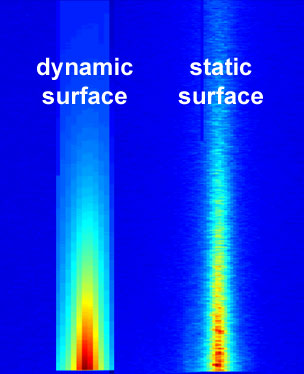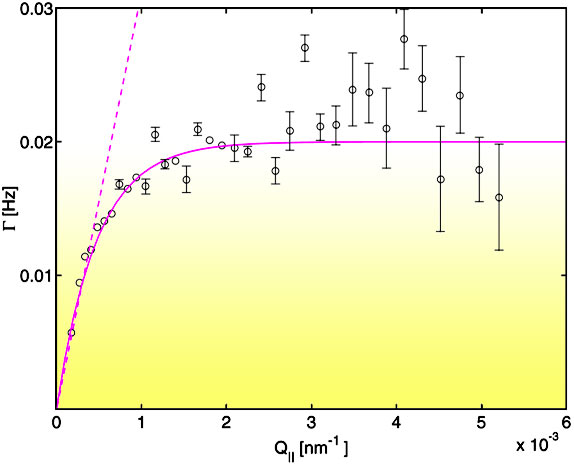- Home
- News
- Spotlight on Science
- Probing Surface...
Probing Surface Dynamics near the Glass Transition by Correlation Spectroscopy with Coherent X-rays
15-02-2005
Recently there has been much debate about confinement effects and the influence of the reduced dimensionality of the glass transition. There has even been speculation about a possible "surface glass transition". By photon correlation spectroscopy with coherent X-rays (XPCS) [1,2] performed under grazing-incidence conditions, we have followed the free surface dynamics of a polymer melt as the glassy state was approached (TG 200 K).
Share
The experiment was performed at ID10A. Two scattering images are shown in Figure 1 from a "dynamic surface" (T = 219 K) and from a "static surface" (T = 190 K). The images were acquired over ~10 minutes with a CCD detector. For the static surface, which is in the glassy state, the image appears grainy. These grains are the so-called "speckles" that are visible whenever coherent light (for instance both visible laser light and coherent X-rays) is scattered from static disorder. For the dynamic surface, the scattering image reminds one of the result of an experiment with a non-coherent beam. This is caused by the fact that the characteristic time-scales of motion of the speckles are much smaller than the acquisition time (10 minutes) and therefore the scattering image taken at 219 K reflects the time-averaged surface structure.
Fig. 1: Surface scattering profiles along the specular rod from a polypropylene glycol melt in the liquid (~219 K) and in the glassy state (~190 K). The right-hand scattering image from the glass appears "speckled" due to the static surface and the coherent X-ray beam employed.
With XPCS, the surface dynamics can be characterised by calculating the temporal auto-correlation function of the speckle images and the result for 214 K is shown in Figure 2. In this high-viscosity regime the surface dynamics is governed by so-called over-damped capillary waves [2] which are characterised by a linear dependency between the scattering vector Q|| and the relaxation rate. This prediction seems only valid in the low Q|| regime where the slope is inversely proportional to the viscosity (see Figure 2). For larger Q||, one observes a decrease of the slope, which, in addition, seems to be Q dependent. Whether that is a signature of a "surface glass transition", a Q-dependant viscosity, or related to other phenomena is currently under investigation. Ongoing studies also include the influence of thermal history and ageing of the glass surface as well as non-ergodicity effects.
Fig. 2: Relaxation rates determined by XPCS as a function of momentum transfer Q|| parallel to the surface (open symbols) at 214 K. The dashed line indicates the prediction for over-damped capillary waves. The solid line is a guide to the eye illustrating the deviation from simple capillary wave behaviour at large Q||.
References
[1] G. Grübel and F. Zontone, J. Alloys and Comp. 362, p. 3-11 (2004).
[2] ESRF Highlights 2003, 58-59 (2003).
Authors
A. Madsen (a), T. Seydel (b), S. Streit (c), M. Paulus (c), H. Sternemann (c), M. Sprung (c,d), C. Gutt (c,e) and M. Tolan (c).
(a) ESRF
(b) ILL
(c) University of Dortmund (Germany)
(d) Now at Advanced Photon Source (USA)
(e) University of California, San Diego (USA)





